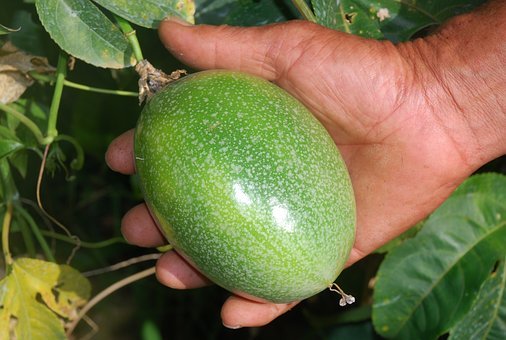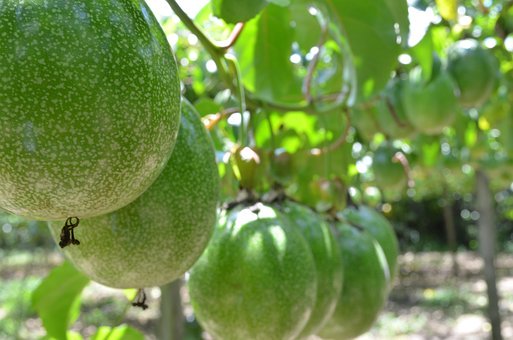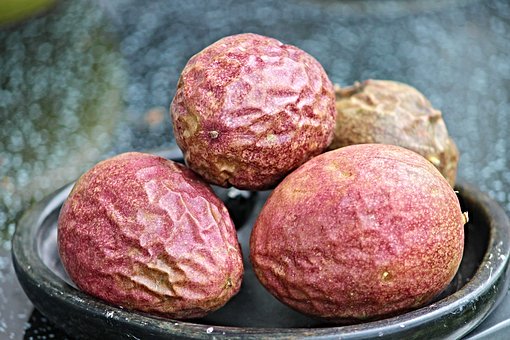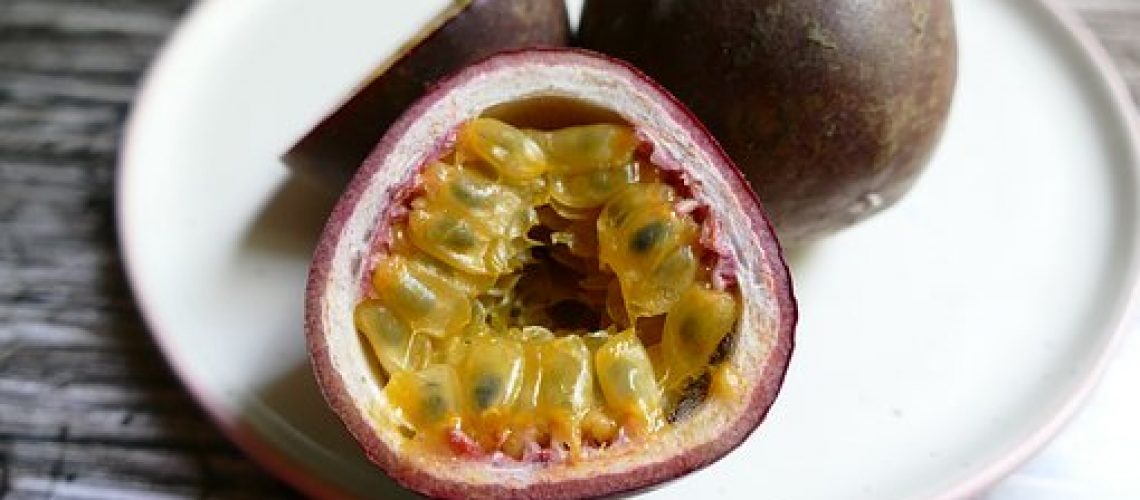Passion fruit is delicious! It has a tough outer rind so you’ll have to cut the fruit in half. Each center is filled with a sweet, slightly tart juicy yellow/orange pulp with seeds. It is delicious alone, blended into a shake, stirred into a drink, or used as a topping for ice cream. It was a family favorite; we never seem to grow enough. But later, as I learned they helped to induce sleep, I’ve eaten one in the evening to combat insomnia!
Passion fruit is the fruit of the Passiflora vine, a type of passion flower. There are several types that vary in size and color. Purple and yellow varieties are the most commonly available. The yellow form has a more vigorous vine and generally larger fruit than the purple, but the pulp of the purple is less acidic, richer in aroma and flavor, and has a higher proportion of juice. Passiflora is a perennial evergreen vine. The hairless leaves stay green all year and the plant’s white flowers with purple to pink crown blooms are unique and beautiful so it can be used ornamentally to decorate a wall or fence.
Although the plant is grown for the passion fruits, the leaves, flowers, peels and stems of the plants are used medicinally.
BENEFITS
Fruit:
- Boosts immunity (rich in vitamin C, beta-cryptoxanthin, and alpha-carotene)
- Increases haemoglobin in RBC (contains iron)
- Regulates thyroid activity (high vitamins B6 and B3)
- May aid in killing cancer cells (yellow passion fruit extract tested, contains carotenoids and polyphenols)
- Used as a sedative
Leaves:
- Lower blood pressure (contains alkaloids, including Harman)
- Used for sedative properties
- Fights spasmodic activity
Flower:
- Helps induce sleep, mild sedative for insomnia
- Used to treat nervous, easily excited children
- Treats bronchial asthma
- Aids in nervous GI disorders
- Alleviates menopause issues
- Sometimes used as mild hallucinogen
Peel of fruit:
- Reduce asthma symptoms (purple fruit peel extract)
- Alleviate pain and stiffness in knee osteoarthritis (purple fruit peel extract)
PLANTING
Passion fruit seeds can take months to germinate if the seeds are old, however if you have a passion fruit, you can separate the seeds from the pulp and those seeds take about 10-20 days to germinate. If you purchase seeds, they are probably older, so those seeds may take months before they germinate.
Usually the plants live only five to seven years. For this reason, I like to propagate the plants by cutting. When we trim the plant back, I save the new growth, strip the bottom leaves and all tendrils, shave off some of the outer stem near the bottom and dip it in rooting hormone. Then I put the cutting about ½ an inch deep in some well-draining soil, and water lightly. Once your cutting takes, you just generated another plant with a life span of five to seven years.
The passionfruit vine grows about 11 yards a year. It will produce fruit about 18 months after planting if they are well-tended. Passionfruit vines are heavy feeders and need plenty of water and well-drained soil. They will need more frequent watering when the fruits are near maturity. Others have recommended citrus food for the vine, but we have had success using vermicompost exclusively. It has never been “overfed” or have any of the issues that may occur when fertilizers are used. For instance, fertilizers can promote leaf growth at the expense of fruit and flowers.
Plant vines next to a sheltered wall, trellis, or deck sheltered from the wind. If planting more than one, space vines at least 6 feet apart.
Passionfruit is available year round but as a tropical fruit, is more abundant in warmer months starting in summer and fall with a small harvest at the end of winter. The longer it stays warm, the more fruit will ripen.
You’ll know a passionfruit is ripe when they feel heavy; that means they are full of the pulp and juice. They can be eaten when just turning from green to purple, but the softer, more wrinkled the skin, the more ripe, less tart, and sweeter the fruit will taste.
TRAINING AND PRUNING
We haven’t done much to train our vine except lightly attaching the main stem to the trellis. When your vine is young, you can pinch off any side shoots and focus the energy on the main stem until it reaches the trellis or support. Once it reaches the physical support, then pinch out the growing tip to force the production of laterals.
Passionfruit vines don’t need pruning at all, but it may be beneficial to remove overgrowth so there is room for the new growth each season. The best time to prune is in spring, right before \ new growth resumes. Be careful not to remove main stems, and only cut back unwanted lateral shoots.
COMMON ISSUES
No fruit?
Passionfruit vines are heavy feeders and need plenty of water. A dry plant will not produce fruit. Check your soil to ensure it is moist. Be sure to add compost regularly.
Some passionfruit varieties require another vine to provide cross-pollination and produce fruit however the commonly grown varieties are self-fertile.
If you are using commercial fertilizers and over fertilizing, you will get flowers but no fruit. Passionfruit only needs food after pruning and after fruiting. Compost can be added anytime.
If the weather suddenly turns cold, the fruit may fall while green.
Flowers dropping?
The most common reason for a passion flower dropping leaves is insect activity. Spider mites are very active during hot, dry periods. They are very tiny and difficult to see, but they leave webs behind. Applying diatomaceous earth on the leaves when dry (without inhaling it into your lungs) should take care of this problem.
Vines are yellowing?
Too much or too little of particular nutrients can cause yellow passion vine leaves. For example, if your soil contains too much boron or too little iron, nitrogen, magnesium, molybdenum, zinc or manganese, the passion vines will yellow. You may want to feed the passion fruit vine blood and bone or aged chicken manure.
Cold weather, windy conditions, or low humdity can also cause the vines to yellow.
Leaves wilting?
Over- or under-watering your purple passion plant can be harmful and cause wilting. The soil should be evenly moist but not soggy. If you’ve overwatered the plant and it looks wilted, don’t water again until the soil feels dry when you push your finger into the soil at a depth of 1 inch.





